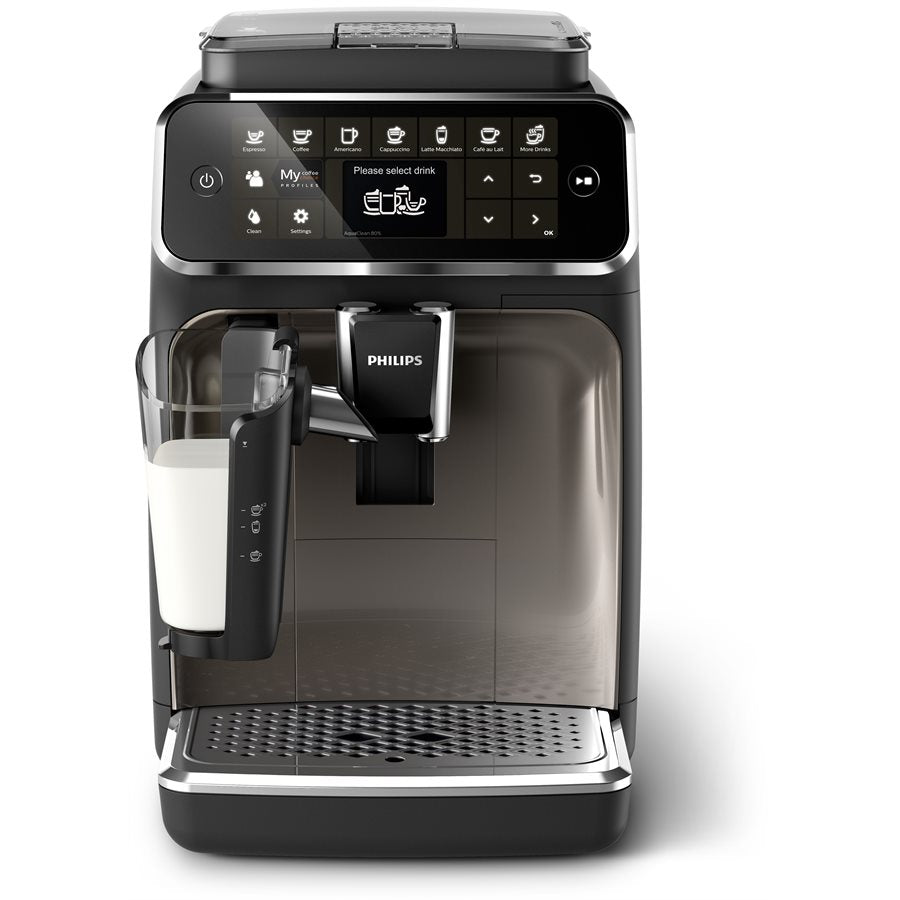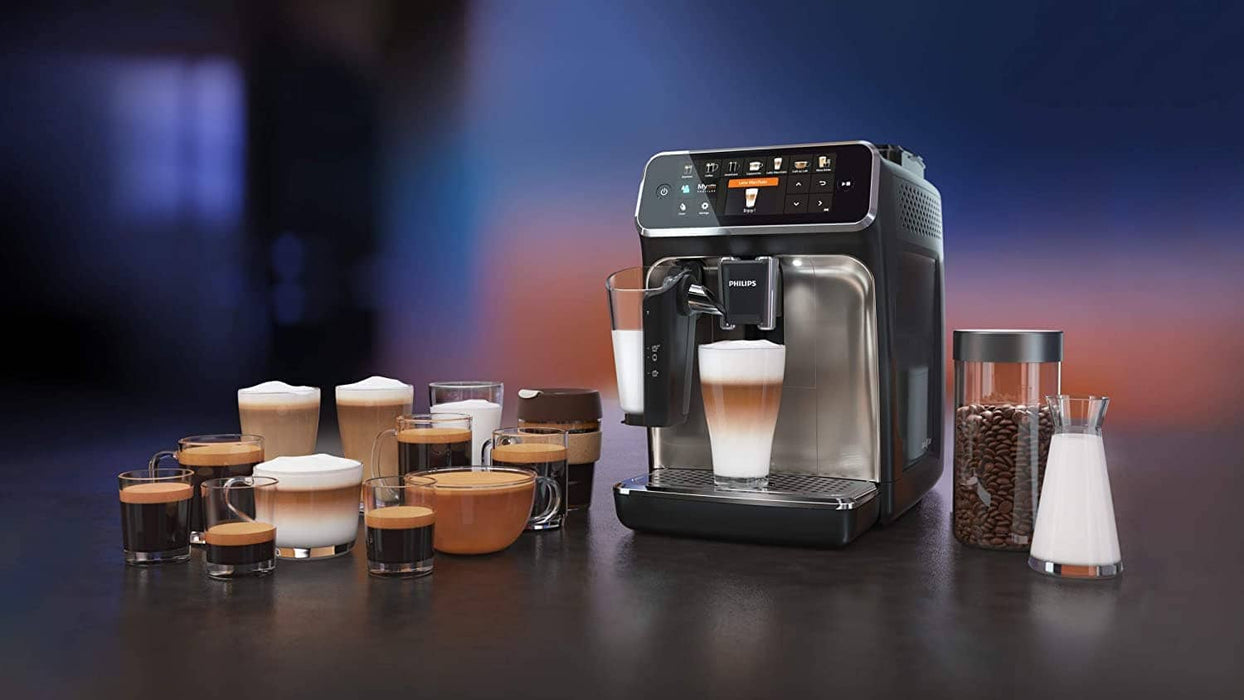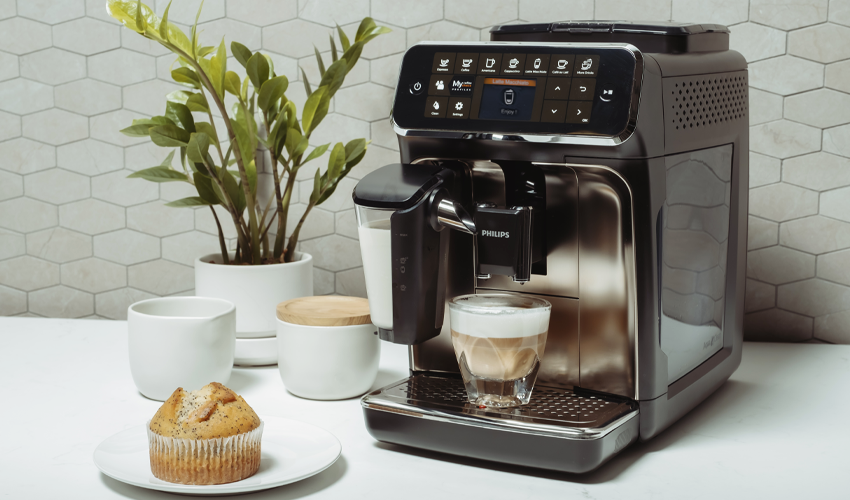#1: Philips LatteGo 5400

- Wide variety of drinks
- Advanced customization
- User profile options
#2: Philips LatteGo 4300

- Basic milk frother
- Small water tank
- Noisy grinder
When it comes to finding the perfect espresso machine for your home, the search can be overwhelming. I've always been a coffee enthusiast, so choosing between the Philips LatteGo 5400 and Philips LatteGo 4300 was a tough decision. After using both machines extensively, I can confidently say that while both have their strengths, the 5400 edges out as the better option for my coffee-loving household. Here's everything I discovered while putting these machines to the test.

First Impressions: Philips LatteGo 5400 vs 4300
From the moment I unboxed the Philips LatteGo machines, I was impressed by the attention to detail in their design. The 4300 has a clean, modern look that fits seamlessly into most kitchens, while the 5400 elevates this with its premium chrome accents. The larger, more vivid touchscreen on the 5400 immediately caught my eye, offering a more refined and intuitive interface.
Both machines are compact and thoughtfully designed, but the 5400 felt just a bit more polished. For me, aesthetics matter because I want my coffee machine to complement my kitchen, not just serve as a functional appliance.
The Range of Beverages: Why More Matters
As someone who enjoys experimenting with different coffee drinks, the range of beverages was a big selling point for me. The Philips LatteGo 4300 offers a respectable eight drinks, covering all the basics like espresso, cappuccino, and latte macchiato. However, the Philips 5400 takes it to the next level with twelve options.
I didn’t realize how much I’d appreciate having drinks like a flat white and café latte available at the touch of a button until I tried them. My partner loves a robust espresso lungo, and I occasionally brew a full cup of coffee in the travel mug mode when I’m on the go. The 5400 caters to all of these preferences, making it the clear winner in this category.
Personalization: Making Coffee Exactly How You Like It
Customization is where the Philips LatteGo 5400 shines. With four user profiles (plus a guest profile), everyone in my family can save their favorite settings. For example, I prefer a medium-strength cappuccino with a lot of foam, while my partner likes a stronger Americano with no milk. Having these preferences saved means no fiddling with the settings every morning, which is a big time-saver.
The 4300 offers two user profiles, which is fine for smaller households, but the 5400 is far more versatile for families or coffee aficionados like me who enjoy experimenting with different settings.

LatteGo Milk System: Convenience Meets Quality
One feature that both machines share—and one I absolutely love—is the LatteGo milk system. It’s genius in its simplicity, with just two parts and no tubes to clean. I can’t tell you how much time this saves compared to other machines I’ve used in the past.
The milk frother creates a creamy, silky froth perfect for cappuccinos and lattes. Cleaning takes less than a minute—just rinse the two parts under the tap or throw them in the dishwasher. While the frothing performance is identical between the two models, the extra drink options on the 5400 make the milk system feel even more versatile.
Daily Use: How Easy Are They to Operate?
Ease of use is critical for any coffee machine, especially when you’re half-asleep in the morning. The 4300 is straightforward and user-friendly, but the 5400’s full-color touchscreen display takes the experience up a notch.
Navigating through drink options, adjusting settings, and even accessing cleaning modes is incredibly intuitive on the 5400. The display adds a sense of luxury that I didn’t realize I would value so much until I started using it daily.
Coffee Quality: The Taste Test
At the end of the day, it all comes down to taste, and both machines deliver excellent coffee. The ceramic grinders in both models ensure precise, consistent grinding, which is crucial for flavor extraction. I also appreciate the Aroma Extract system, which maintains the ideal brewing temperature and ensures my coffee always has a full-bodied flavor.
However, the 5400 has an extra shot function that allows me to boost the intensity of my coffee. This feature has been a game-changer for those early mornings when I need an extra caffeine kick.

Cleaning and Maintenance: A Hassle-Free Experience
One thing I cannot compromise on is ease of maintenance. Both machines make this incredibly simple with their removable brewing groups and the AquaClean filter, which reduces the need for descaling.
The LatteGo milk system is by far the easiest frothing system I’ve ever cleaned. The fact that it’s just two parts and completely tube-free means there’s no worry about milk residue building up in hard-to-reach areas.
Noise Levels: A Subtle Improvement
I live in an apartment with thin walls, so noise is a consideration for me. Both machines are relatively quiet, but the Philips 5400 has noticeably reduced noise during brewing, thanks to its SilentBrew technology. It’s not a huge difference, but I certainly appreciate the quieter operation when I’m making coffee early in the morning.
Who Should Choose the Philips LatteGo 4300?
The 4300 is an excellent choice if you’re looking for a high-quality, no-frills espresso machine. It’s perfect for smaller households or individuals who stick to classic coffee drinks. If you’re on a tighter budget and don’t mind fewer customization options, the 4300 will serve you well.
Who Should Choose the Philips LatteGo 5400?
For those who want more versatility and convenience, the 5400 is the way to go. The expanded drink menu, multiple user profiles, and enhanced touchscreen display make it ideal for families, coffee enthusiasts, or anyone who wants to enjoy a barista-level experience at home.
Product Review Conclusion: Philips LatteGo 5400 vs 4300
After weeks of testing both machines, I’ve come to appreciate the thoughtful design and excellent coffee quality of the Philips LatteGo series. Both the 4300 and 5400 are outstanding machines, but the 5400 takes the lead with its enhanced features and added convenience.
If you’re someone who values variety, personalization, and a touch of luxury in your coffee-making routine, the Philips LatteGo 5400 is worth the investment. On the other hand, if you prefer a simpler setup without compromising on coffee quality, the Philips 4300 is a fantastic option.
At the end of the day, either machine will elevate your coffee experience, but for me, the 5400 has been a game-changer. It’s the machine I find myself reaching for every morning, and it continues to impress me with its performance and versatility.
Frequently Asked Questions
Q1: What are the main differences between the Philips LatteGo 5400 and 4300?
A1: The Philips LatteGo 5400 offers twelve beverage options compared to the eight available on the 4300. It also supports four user profiles, features a larger full-color touchscreen display, and includes an extra shot function for stronger coffee.
Q2: How easy is it to clean the LatteGo milk system?
A2: The LatteGo milk system is designed for easy cleaning, consisting of only two parts with no tubes. You can clean it under running water or place it in the dishwasher, taking only about 15 seconds to rinse.
Q3: Is the coffee quality different between the two models?
A3: Both machines use ceramic grinders and the Aroma Extract system, ensuring high-quality coffee. However, the 5400 has an extra shot function that enhances the coffee's strength and flavor, making it a better option for those who prefer a bolder taste.
Q4: Can I customize my coffee settings?
A4: Yes, both models allow for customization, but the 5400 has more options. The 4300 supports two user profiles, while the 5400 supports up to four profiles and a guest profile, allowing multiple users to save their preferred settings.
Q5: Are the machines energy efficient?
A5: Yes, both the Philips LatteGo 5400 and 4300 are designed with energy efficiency in mind. They feature an automatic shut-off function that can be programmed to turn off the machine after a period of inactivity, helping to reduce energy consumption.
Q6: What is the warranty period for these machines?
A6: Both the Philips LatteGo 5400 and 4300 typically come with a two-year warranty, covering any manufacturing defects. It's advisable to check the warranty specifics at the time of purchase.
Q7: How long does it take to make a cup of coffee?
A7: The time to brew a cup of coffee varies depending on the drink selected. Generally, it takes around 30 seconds to a minute for the machine to grind the beans, brew the coffee, and froth the milk, depending on the complexity of the drink.
Q8: Can I use my own coffee beans with these machines?
A8: Yes, both machines allow you to use your preferred coffee beans. The built-in grinders can accommodate a variety of coffee bean types, letting you customize your coffee experience.
Q9: Is there a difference in noise levels between the two models?
A9: Both models operate relatively quietly, but the Philips LatteGo 5400 includes SilentBrew technology, which reduces noise levels during brewing compared to the 4300.
Q10: Are the machines suitable for beginners?
A10: Absolutely! Both the 5400 and 4300 are user-friendly, with intuitive controls and helpful features that make them suitable for beginners. The clear touchscreen display guides users through the brewing process.
